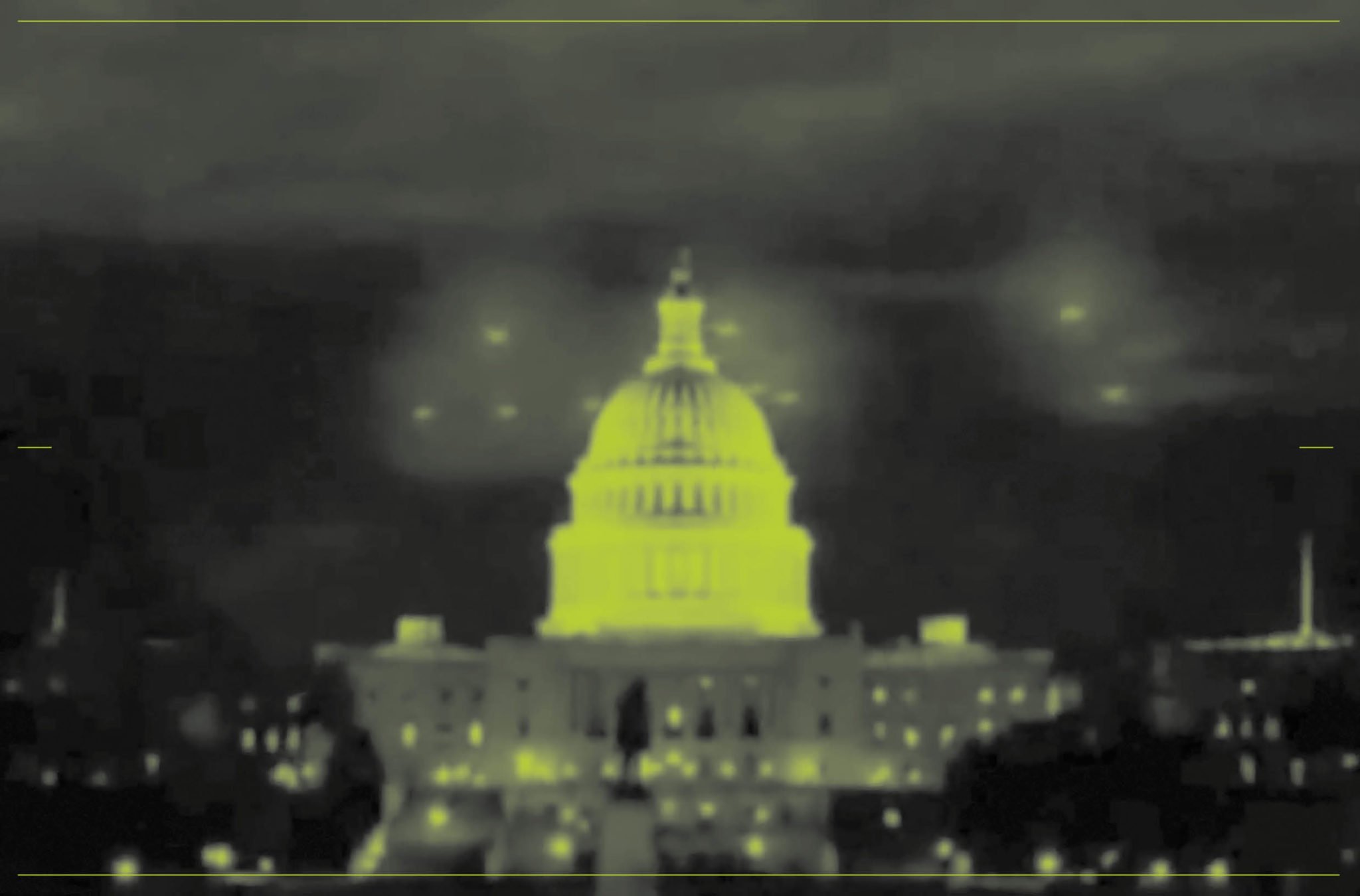Just before midnight on July 19, 1952, a Washington National Airport air traffic controller spotted seven unusual objects on radar—first hovering about 15 miles south-southwest of the city, later floating above the White House and the Capitol. That same night, an airman at Andrews Air Force Base saw an “object which appeared to be like an orange ball of fire, trailing a tail.” The pilot of a departing commercial flight spotted six “white, tailless, fast-moving lights.” The mysterious objects disappeared from radar upon the arrival of two Air Force jets, then reappeared when the jets left. The following weekend, more inexplicable lights glimmered over DC, prompting the Air Force to send jets after the objects. Once again, the anomalies vanished.
In a press conference that week, Air Force Chief of Intelligence Major General John Samford attributed the bizarre radar activity to a temperature inversion. Project Blue Book—the Air Force’s UFO investigation program—deemed this theory inadequate. The CIA formed a study group to analyze the sightings, and by the following year, had concluded that UFOs were not a viable national security threat.
More than 70 years later, officials still can’t explain what actually happened. However, if you’re among the majority of Americans who currently believe in intelligent life beyond Earth, take heart: on Wednesday, the House Oversight Committee will hold a hearing on the subject of UAPs—“unidentified anomalous phenomena,” an increasingly popular term to describe these airborne mysteries.
The House hearing comes more than a year after whistleblower David Grusch accused the Pentagon of running a secret UFO retrieval program. And as government officials appear to be rolling up their sleeves on the UAP issue, rest assured that the general public has long been keeping a watchful eye on the sky—including right here in the DC area.
Alejandro Rojas is a consultant for Enigma Labs, a platform that aggregates photo, video, and witness testimony of UAP sightings across the country. The company emphasizes its nonpartisanship, and remains neutral on the origins of the UAPs their users report. That’s part of why they stick with the phrase “UAP”: As Rojas puts it, “the term ‘UFOs’ got baggage over time,” and they don’t want to conjure up any extraterrestrial connotations—they’re simply pursuing “the scientific investigation of something unknown.”
Enigma has been up and running for about a year and a half; since then, they’re received more than 25,000 UAP reports across the globe—but mostly from Americans. According to Rojas, sightings correlate with population, so the biggest share of their data originates from users in California, Texas, and Florida. Based on its sheer quantity of reports, DC is not a hotspot—but it’s interesting anyway.
“It is one of the largest areas of secured airspace,” Rojas says. “So you would expect that area would be very heavily monitored, which it is. But despite that, sometimes we do get weird objects.”
Enigma users have reported 23 UAP sightings in the DC area so far. The most recent report was uploaded last week: a user posting about “silvery disk shapes” in the sky outside their window. Last October, two colleagues noticed “a shiny metallic object” floating past their office—they thought it was a balloon, until it started making “odd maneuvers.”
These user testimonies have helped Enigma to establish a UAP social network of sorts. “We wanted an easy way for people to be able to submit reports, but also look at other reports, because often when people see something, they’re like, ‘Wow, did anybody else see this thing that I saw?’” Rojas says.

The platform also aims to clear up any confusion surrounding whether an object is truly “unidentified.” Rojas says users “are getting more savvy around what they’re seeing,” but Enigma will step in to clarify when a reported UAP is actually a known object. For example, some reports mistake SpaceX’s Starlink satellites for UAPs, like this one from May 2023.
But when there’s no readily available explanation for a user sighting, Enigma won’t jump to any conclusions. Its goal is simply to collect the reports and, in some cases, pass them along to “researchers who may be interested in doing some more analysis and science around them,” according to Rojas. Some of those researchers are, of course, interested in aliens. Others are concerned with drones flying over secured military airspace. Some study rare weather events, like ball lightning, which can be mistaken for UAPs.
“We’re helping to gather data so that data can be analyzed, so we can figure out more about what the phenomena is,” Rojas says.
Since its launch, Enigma developers have noticed their platform filling an emotional need. Oftentimes, Rojas says, people will try to talk to family or friends about their unexplained sightings, “and they’re just completely shut down and told, ‘We don’t want to talk about it. That’s goofy.’” By approaching the subject from a perspective of scientific interest, he hopes the company’s work can shake some stigma off the UAP conversation and create a safe space for discussion—somewhere to take off your tinfoil hat, and stay a while.


















